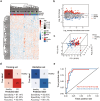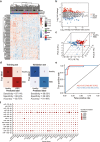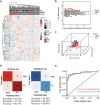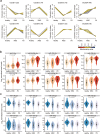Candidate biomarkers of EV-microRNA in detecting REM sleep behavior disorder and Parkinson's disease
- PMID: 38200052
- PMCID: PMC10781790
- DOI: 10.1038/s41531-023-00628-4
Candidate biomarkers of EV-microRNA in detecting REM sleep behavior disorder and Parkinson's disease
Abstract
Parkinson's disease (PD) lacks reliable, non-invasive biomarker tests for early intervention and management. Thus, a minimally invasive test for the early detection and monitoring of PD and REM sleep behavior disorder (iRBD) is a highly unmet need for developing drugs and planning patient care. Extracellular vehicles (EVs) are found in a wide variety of biofluids, including plasma. EV-mediated functional transfer of microRNAs (miRNAs) may be viable candidates as biomarkers for PD and iRBD. Next-generation sequencing (NGS) of EV-derived small RNAs was performed in 60 normal controls, 56 iRBD patients and 53 PD patients to profile small non-coding RNAs (sncRNAs). Moreover, prospective follow-up was performed for these 56 iRBD patients for an average of 3.3 years. Full-scale miRNA profiles of plasma EVs were evaluated by machine-learning methods. After optimizing the library construction method for low RNA inputs (named EVsmall-seq), we built a machine learning algorithm that identified diagnostic miRNA signatures for distinguishing iRBD patients (AUC 0.969) and PD patients (AUC 0.916) from healthy individuals; and PD patients (AUC 0.929) from iRBD patients. We illustrated all the possible expression patterns across healthy-iRBD-PD hierarchy. We also showed 20 examples of miRNAs with consistently increasing or decreasing expression levels from controls to iRBD to PD. In addition, four miRNAs were found to be correlated with iRBD conversion. Distinct characteristics of the miRNA profiles among normal, iRBD and PD samples were discovered, which provides a panel of promising biomarkers for the identification of PD patients and those in the prodromal stage iRBD.
© 2024. The Author(s).
Conflict of interest statement
The authors declare no competing interests.
Figures





Similar articles
-
Serum MicroRNAs Predict Isolated Rapid Eye Movement Sleep Behavior Disorder and Lewy Body Diseases.Mov Disord. 2022 Oct;37(10):2086-2098. doi: 10.1002/mds.29171. Epub 2022 Aug 12. Mov Disord. 2022. PMID: 35962561 Free PMC article.
-
Parkinson Disease-Related Brain Metabolic Patterns and Neurodegeneration in Isolated REM Sleep Behavior Disorder.Neurology. 2021 Jul 27;97(4):e378-e388. doi: 10.1212/WNL.0000000000012228. Epub 2021 May 19. Neurology. 2021. PMID: 34011571
-
The Metabolic Pattern of Idiopathic REM Sleep Behavior Disorder Reflects Early-Stage Parkinson Disease.J Nucl Med. 2018 Sep;59(9):1437-1444. doi: 10.2967/jnumed.117.202242. Epub 2018 Feb 23. J Nucl Med. 2018. PMID: 29476004
-
From Rapid Eye Movement Sleep Behavior Disorder to Parkinson's Disease: Possible Predictive Markers of Conversion.ACS Chem Neurosci. 2019 Feb 20;10(2):824-827. doi: 10.1021/acschemneuro.8b00388. Epub 2018 Oct 1. ACS Chem Neurosci. 2019. PMID: 30222303 Review.
-
Research progress on neuromolecular imaging of REM sleep behavior disorder.Front Neurol. 2022 Oct 10;13:1009907. doi: 10.3389/fneur.2022.1009907. eCollection 2022. Front Neurol. 2022. PMID: 36299269 Free PMC article. Review.
Cited by
-
Emerging Role of Extracellular Vesicles as Biomarkers in Neurodegenerative Diseases and Their Clinical and Therapeutic Potential in Central Nervous System Pathologies.Int J Mol Sci. 2024 Sep 19;25(18):10068. doi: 10.3390/ijms251810068. Int J Mol Sci. 2024. PMID: 39337560 Free PMC article. Review.
-
MicroRNA-361-3p Regulates Autophagy and Apoptotic Processes by Regulating PI3K/Akt Signaling in Parkinson's Disease.Neurochem Res. 2025 Jun 30;50(4):221. doi: 10.1007/s11064-025-04435-6. Neurochem Res. 2025. PMID: 40586827
-
From Night to Light: A Bibliometric Analysis of the Global Research Trajectory of Sleep Disorders in Parkinson's Disease.J Multidiscip Healthc. 2025 Jan 30;18:473-492. doi: 10.2147/JMDH.S503849. eCollection 2025. J Multidiscip Healthc. 2025. PMID: 39902191 Free PMC article.
-
Artificial intelligence based advancements in nanomedicine for brain disorder management: an updated narrative review.Front Med (Lausanne). 2025 May 13;12:1599340. doi: 10.3389/fmed.2025.1599340. eCollection 2025. Front Med (Lausanne). 2025. PMID: 40432717 Free PMC article. Review.
-
Electrochemical Biosensors for the Detection of Exosomal microRNA Biomarkers for Early Diagnosis of Neurodegenerative Diseases.Anal Chem. 2025 Mar 18;97(10):5355-5371. doi: 10.1021/acs.analchem.4c02619. Epub 2025 Mar 9. Anal Chem. 2025. PMID: 40057850 Free PMC article. Review.
References
Grants and funding
LinkOut - more resources
Full Text Sources
Molecular Biology Databases

